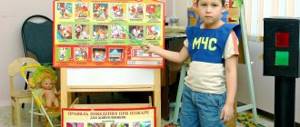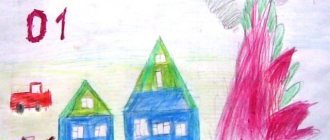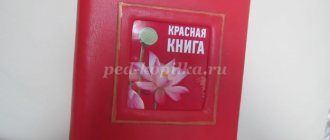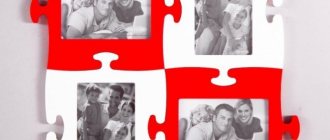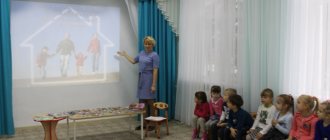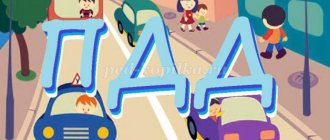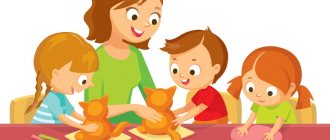Tourist trip with children of the senior group of kindergarten. Scenario
Scenario for a hike with older children Topic: “A fun hike with Boleyka”
Author of the work: Svetlana Alekseevna Semenova Teacher of the MK Preschool Educational Institution, kindergarten No. 1, Muezersky village, district. Karelia Description of material: A scenario for a tourist trip with older children is presented. The material may be useful to teachers of preschool institutions. Goal: Development of physical qualities and strengthening the health of children during a hiking trip. Objectives: To provide children with the opportunity to use motor skills and abilities acquired previously. Improve the health of children's bodies while walking. To consolidate knowledge about the rules of behavior during walks in nature. Develop agility, coordination of movements, speed of reaction, endurance. Create an atmosphere of goodwill. Cultivate strong-willed and friendly qualities. Preliminary work: Classes in the “Young Tourist” club: Thinking through and studying the route, examining the clearing. Before going for a walk, check children's clothes and shoes. Prepare water for drinking and washing hands, a first aid kit, and sports equipment. Conversation and permission from parents. Equipment: Backpacks, 3 balls, 4 hoops, 2 jump ropes, badminton, small ball, first aid kit, paired pictures, paper towels, wet wipes, disposable tablecloth or oilcloth, towel, candy, cookies, drinking water, sweet tea.
Progress of the event:
Boleyka comes to the children's group. He complains that he is sick all the time, so he sits at home. The teacher with the children invites him to go on a hike with the children and gain health in the fresh air.
The participants of the hike leave the kindergarten and walk along a pre-planned route. Walking with backpacks behind each other, overcoming various obstacles encountered along the way. Exit to the clearing.
Children rest, drink water.
Boleyka: Finally, they've arrived! And there is no hospital nearby. What will I do: - if I prick my finger or scratch it (rinse it with water, smear it with brilliant green or iodine, cover it with a band-aid) - and if I overheat in the sun (create a shadow, put a napkin soaked in cold water on my forehead, bring ammonia to my nose) Sore throat : Well, now you can lie on the grass, scream at the top of your lungs, break branches, throw jars into the water. Host: Guys, do you agree with Boleyka? (Children's answers). I knew that you were not like Boleyka. Tell us how you will behave in the forest. (Children answer). That's right, you can't tear or break anything. You can't shout or throw trash. We are visiting nature here, and when visiting we need to behave politely and respectfully. Boleyka: You can’t break branches, you can’t yell, but what should you do then? Host: Let's play instead. “Find a Pair” Children are given pictures depicting natural objects.
On command: “One, two, three – find yourself a mate!” Each child must find and hold hands with someone who has exactly the same picture. Then the children name what is shown in their picture and what they know about this natural object. Boleyka: I’m already tired, I don’t have any strength left. Host: But the guys weren’t tired at all. Now you will see how dexterous, fast, and resilient they are. Relay races are held:
1. “Don’t drop the ball” Teams stand in a column, one at a time, behind the starting line. The first participants have the ball between their knees. At the signal, they must reach the tree, overtake it and go back, pass the balls to the next participant and stand at the end of the column.
2. “Spiders” Teams line up behind the starting line in a column of two. Backs to each other. At the signal, the first ones run, run around the trees, come back, pass the baton by touching their hands and stand at the end of the column.
3. “Climb through without hitting the hoop.” Teams form a column, one at a time, behind the starting line. In front of each team is an adult holding two hoops at their sides. At the signal, the first participants in the relay climb through the hoops, run around the tree, return in the same way, pass the baton to the next participant and stand at the end of the column. Boleyka: I see that you are clever and strong guys. But now I’ll tell you riddles and see if you’re smart. 4. Riddles In the spring he dresses, in the fall he undresses. (Forest) You and I are walking along the carpet, no one wove it, Only the light of the sun warmed it and the rain poured down. It spread out by itself, and is called ... (grass). They grow in the summer and fall off in the fall. (Leaves). A friend, green and good, will help us in the rain and in the heat - He will stretch out a dozen hands and thousands of palms to us. (Tree). He breathes, grows, but cannot walk. (Plant). You will always find her in the forest - let's go for a walk and meet her: Standing there, prickly, like a hedgehog, in winter in a summer dress. (Spruce, pine) I drilled the ground and left the root. He came into the world himself and covered himself with a cap. (Mushroom). Host: Well, Boleyka, I’m convinced that our guys can solve riddles. Boleyka: Let's play some more, collect cones into a hoop. 5. “Whose team will collect more cones into a hoop?” In 30-40 seconds, children collect cones into a hoop. The team that collects the most cones wins.
Host: That's how nice we played. It's time to rest and refresh yourself. A picnic is arranged. Then the collection of natural materials, throwing pebbles into the water, playing football, badminton, jumping rope, games with a small ball (optional) are organized. Presenter: Our hike is coming to an end. Before you leave, gather your belongings and check to make sure you haven't left any trash behind.
Boleyka: Thank you guys, now I won’t get sick. I’ll take more walks outside and breathe fresh air. Children return to kindergarten.
We recommend watching:
Leisure scenario in kindergarten in the senior group “Greetings Day” Summary of entertainment on the basics of a healthy lifestyle in the senior and preparatory group Summary of an open lesson on the topic Tourism for children 5-9 years old Summary of a lesson for children 12-15 years old on the topic: Types of tourist fires
Similar articles:
The final event of the thematic week “Folk Crafts of Russia”
Scenario of entertainment according to traffic rules in the senior group together with parents
Scenario of the play for children of senior preschool age
GCD entertainment scenario for older preschoolers for World Children's Day
Summary of physical education entertainment in the senior group
Tourism in kindergarten "Kaleidoscope"
Tourism (French tourisme from - tour - walk, trip) - travel in one's own country or to other countries, combining recreation with elements of sports and educational tasks (Dictionary of Foreign Words. - M., 1989). Preschool tourism solves not only educational problems, but also health-improving tasks, improves the motor abilities of children, and contributes to their mastering of the simplest tourist skills. It has long been known that nothing brings a family together and helps to achieve mutual understanding between all family members like a joint hike. Hiking is an active way for tourists to travel along a designated route (on foot, on skis, by bicycle, etc.). The hike combines the implementation of educational tasks with the organization of camp life conditions. A tourist walk includes a form of organizing tourism activities that involves a short stay of tourists in natural conditions and the acquisition of partial tourism skills. [1]
An important task of educating the younger generation is a sense of patriotism, the formation in children and parents of the need for a healthy lifestyle as an indicator of universal human culture; introducing children and adults to the traditions of big-time sports and sports tourism; formation of ideas about what is useful and what is harmful to the body. Great potential opportunities for children and their patriotic education lie in tourist and local history trips. It allows preschool children to take themed walks and excursions, get acquainted with their native culture, explore their country, starting with the “small Motherland of the city of Cheboksary,” and learn the patriotic, labor, spiritual and moral traditions of the Chuvash people. Children of senior preschool age 6–7 years old are distinguished by a fairly high degree of independence and organization, which is an indispensable condition for organizing motor activity that is longer and more complex in content and methodology in natural conditions. We are talking about children's tourism, which solves not only educational, but also health-improving tasks, improves the motor abilities of children, and contributes to their development of tourism skills. [1] Tourism in kindergarten is life education for little pupils, a school of courage and patriotism, because each trip requires new knowledge and skills from both teachers and preschoolers. Our kindergarten, which has been practicing this form of work with children for several years, notes that children's tourism has established itself as an effective form of active recreation, which allows, with minimal time and effort, to increase health reserves; restoring strength, efficiency, expanding the horizons of communication, the functionality of the child’s body, enriching the motor experience of preschool children, replenishing the amount of knowledge in the field of tourism, local history and culture of their hometown.
In MBDOU “Kindergarten No. 184 “Kaleidoscope”, work is underway with preschool children to develop initial ideas and basic knowledge in the field of tourism. The combination of tourism, local history and culture of their native land allows preschoolers to take their first independent steps in tourism activities and in exploring their city. Working with preschool children has a number of features that distinguish it from other tourism programs for older children, namely: a system of interconnected walks, hikes, as well as physical education and educational activities, united by a storyline, revealing in detail the content of the program; the presence of a rational combination of motor, play and cognitive activities; the content of physical education classes with a tourist focus with the tasks of a standard education and training program in a preschool institution.
The work involves the use of traditional methods of physical education: playful, competitive, strictly regulated exercises. The leading method is the game method. [2] The methods and forms of working with children presented in this article can be useful for preschool teachers, school teachers, additional education teachers, and teacher-organizers in their future professional activities. Tourism activities (provided they are systematic) compensate for the so-called motor deficit of movements. Walking walks and excursions outside the children's institution are the simplest type of children's tourism. They promote health, physical development of children, education of aesthetic feelings, improvement of motor skills and physical qualities. [1] In the preschool institution “Kindergarten No. 184 “Kaleidoscope” for young tourists in the city of Cheboksary, work on tourism and local history with children, parents and teachers has been organized. In MBDOU "Kindergarten No. 184 "Kaleidoscope", a section "Young Tourists" has been organized for preschool children. Children aged 4–7 years take part in this section. In the process of mastering the basics of tourism, they broaden their horizons, learn to respect nature, acquire and consolidate the skills of a healthy lifestyle and the cultural heritage of the Chuvash people. The section has not existed for long, but the results are already pleasing to parents and kindergarten teachers. Work on organizing children's tourism consists of several areas: work with children, parents, teachers, employees of preschool educational institutions and with the UNITEX community. Work with preschool children in tourism and local history is designed for a long period of study. The main goal of the work is to develop in preschool children initial ideas, knowledge about tourism, and a conscious correct attitude towards nature through the development of cognitive activity in studying their native land. At the same time, children gain knowledge and ideas about tourism, elements of orienteering, get acquainted with flora, fauna, traditions, famous people of Chuvashia, ornaments, etc.
A peculiarity of the organization of the educational process in tourism and local history is the versatile forms of its implementation. Fundamental changes in the forms of organizing the lesson are that the lesson, if possible, is transferred to the environment that is being studied (park, forest, pond, kindergarten site, museum, street, house, vacation spot, etc.). As many excursions, targeted walks, themed games and outdoor celebrations as possible to expand the educational space. In the course of educational work, systems of rules of behavior and life activities of children are studied. For this purpose, the following forms of classes are used: group, individual, combined, excursions, walks, outdoor games, thematic games with elements of tourist equipment, orienteering games, relay competitions.
Exciting competitive games help teachers check how successfully children have mastered tourism skills. The students are happy to complete the proposed tasks: pack a backpack for a hike, putting only the most necessary things, knit simple tourist knots, recognize plants and animals in pictures that are typical of their native land. The “Tourist Obstacle Course” relay race evokes a storm of emotions: to the screams of fans, kids cross an improvised bridge, jump over “bumps,” fly over an imaginary river with the help of a rope, and climb through “forest wilds.”
In their work with children, teachers try to be in the fresh air as much as possible. Through excursions to the forest, walks, outdoor activities, and entertainment, children gain the necessary experience, learn to explore and observe natural phenomena, and take care of their health. A tourist walk in the forest, in a meadow, to a river, or to a lake is always positive emotions, joyful communication, and an opportunity to evaluate one’s strengths and abilities in overcoming new obstacles. However, the value of preschool tourism is not limited to issues of health improvement and physical development. Collective walks contribute to the formation of a children's team, in which everyone is connected by one goal, where the child feels involved in a common cause and sees the benefits it brings. Walking instills in children the most important moral qualities, developing organization, responsiveness, generosity, and goodwill. Thus, tourism is an excellent means of comprehensive development of a child’s personality. [4]
Tourism is an excellent means of active recreation. It helps children develop the ability to organize their leisure time in an interesting and meaningful way. The positive emotions that a child experiences during tourism forms a strong need to lead a healthy lifestyle. [5]
Thoughtful, interestingly organized motor activity of children in natural conditions develops pupils' interest in tourism and physical education, and increases motivation for a healthy lifestyle.
It is still unknown whether children will become tourists in the future. But in any case, the valuable knowledge and skills acquired in a preschool institution will definitely be useful to them in life.
Literature:
- Bocharova N.I. Tourist walks in kindergarten: a guide for practical purposes. preschool workers education Institutions [Text] / N. I. Bocharova//Development and education of a preschooler.-M.: Arkti, 2004.-115 p.
- Zavyalova T. P. Tourism in kindergarten: new opportunities, new solutions [Text] / T. P. Zavyalova // Educational methods. Benefit / Tyumen. state Univ.-Tyumen, 2006.-263p.
- Alyamovskaya V. G. Modern approaches to the health of children in a preschool educational institution [Text] / V. G. Alyamovskaya // Moscow: Pedagogical University “First of September”. - 2005.
- Stepankova E. Ya. Theory and methodology of physical education and child development [Text] /E. Y. Stepankova // Textbook. manual for higher students textbook institutions.- 2nd ed.. revised.- M.: Publishing House, 2006.-368 p.
- Bocharova N.I. Tourist walks in kindergarten [Text] / N.I. Bocharova//Manual for practical workers of preschool educational institutions. - M.: ARKTI, 2004. - 116 p.
- Keneman A.V. Theory and methods of physical education of preschool children: Textbook. manual for students [Text] / A. V. Keneman, D. V. Khukhlaeva - 3rd ed. - M.: Education, 1985.-271 p.
